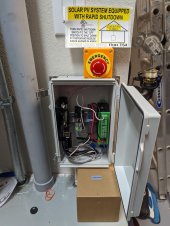timselectric
If I can do it, you can do it.
- Joined
- Feb 5, 2022
- Messages
- 18,823
I'm old school.
I'll just take screenshots, 3 times a day. lol
I'll just take screenshots, 3 times a day. lol
He has been saying that for 6-8 months. I think the deadline he gave was September and still nothing.Supposed to be coming.
Hopefully soon.
You cannot retrieve the Data unless by some miracle the SD card database can be rebuilt.Hopefully not. But time will tell.
For now, I'll just swap in a new card if it happens again. And hopefully the data can be retrieved later.
It's on the card.You cannot retrieve the Data unless by some miracle the SD card database can be rebuilt.
The data is not stored on a SA cloud server. All his system does is provide basically a Free DDNS service to redirect request from his servers back to your Pi.
Does your laptop fit on a DIN mount next to the inverter? I don't need a keyboard, display and trackpad for a headless setup that just does its thing.Used ThinkPad laptops are excellent for use in monitoring and serving data. These laptops use minimal power when the display is off and an SSD makes them almost indestructible. Most if not all ThinkPads will run Linux with no problems.
A good used laptop can often be cheaper than a single board linux solution. And they come with a display, keyboard, power supply and trackpoint.


That is all wonderful. The point is that you somehow have to interface with your inverter's Comms port. So whether you want to build an elaborate bridge setup to get data out from the inverter to your laptop, or you want to host the laptop close to the inverter or you just want to put a small ARM processor based headless device by the inverter is what we're discussing here.No, I have a couple laptops that just sit on a shelf. Connected via ethernet cable to network. No need for an electrical box.
I was a DIY everything kind of guy up until about 15 years ago. Then I started to choose my battles more carefully.I don't know what kind of hourly rate you guys make but there came a time in my life where I will just pay the $100 for the turn key solution rather than try to build it on my own and spend 80 hours on something. I have far higher priority tasks to spend my time on.


